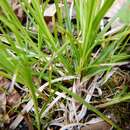Comprehensive Description
provided by North American Flora
Carex peckii Howe; Peck, Ann. Rep. N. Y. St. Mus 47: 166. 1894.
Carex Emmonsii var. elli plica Boott, 111. Carex 97. pi. 287. 1860. (Type from northwestern North
America.) ■Carex albicans Willd." L. H. Bailey, Bot. Gaz. 21: 7. 1896. Carex c/iMco/a Fernald & Weatherby, Rhodora33: 233. 1931. (Type from Mt. St. Pierre, Gasp6.
Quebec.)
Loosely cespitose and stoloniferous, the rootstocks slender, scaly, the culms 1.5-6.5 dm. high, slender but erect, more or less strongly exceeding the leaves, triangular, roughened beneath spikes, mostly central and phyllopodic, some lateral and aphyllopodic, reddish-purple at base and bearing several long-bladed, dried-up leaves of the previous year; sterile culms elongate, aphyllopodic, lateral, the well-developed leaves towards the top, the lower sheaths breaking ventrally and becoming filamentose; fertile culms bearing several leaves of the year with well-developed blades, all on the lower fourth, the blades erect-ascending, short, 1.5-4 cm. long, 1-1.5 mm. wide, flat, green, not stiff, roughened on the margins and towards the apex, the sheaths tight, truncate at mouth, the ligule short, the blades of the sterile culms much longer (sometimes 15 cm. long), 1.5-3 mm. wide; staminatc spike and the 2 or 3 pistillate spikes closely aggregated or approximate, the inflorescence 0.8-2 cm. long; basal spikes absent; staminatc spike usually small and incon.spicuous, exceeded by the pistillate spikes, sessile, linear, 1-13 mm. (usually 3-6 mm.) long, 0.5-1 mm. wide, the scales few, closely appressed, obovate, acute, rcddi.sh-brown, with conspicuous white-hyaline margins and lighter center; pistillate spikes sutiorbicular or short-oblong, 4-8 mm. long, 4 mm. wide, closely sessile, closely flowered with 1-12 ascending perigynia; lowest bract leaflet-like, green, shcathless. not colored at base, from shorter than to slightly exceeding the inflorescence; scales suborbicular, short-mucronate to obtusish, not ciliate, wider than but only about half the length of the bodies of the mature perigynia, light-reddish-brown, with broad white-hyaline margins and lighter center, the midvein green, roughish, sharply defined; perigj'nia oblong-obovoid, obtusely triangular, 3.5 mm. long, 2-ridged, otherwise nerveless, hirsute-pubescent, grayishgreen or yellowish-green at base, membranaceous, the body oval-obovoid, 2 mm. long, 1 mm. wide, completely filled by achene, stipitate, long-tapering to a spongy base 0.5 mm. long, and abruptly contracted into a short slender beak 0.5 mm. long, somewhat obliquely cut, bidentate, hyaline at the orifice; achenes oblong-obovoid, triangular, with convex sides and blunt green angles, yellowish-brown, 2 mm. long, 1 mm. wide, tapering at base, minutely apiculate; style very short, black, slightly enlarged at base, jointed with achene, deciduous; stigmas three, dark-reddish-brown, slender.
Type locality: "Helderberg mountains. Albany county; Brownville, Jefferson County; Elizabethtown, Essex County." New York.
Distribution: Open woods in limestone districts, Quebec to Yukon, and southward to northwestern New Jersey, northern Michigan, the Black Hills of South Dakota, and British Columbia. (Specimens examined from Quebec, New Brunswick, Maine, New Hampshire, Vermont, New York, northwestern New Jersey. Ontario. Michigan, Wisconsin, Minnesota, Manitoba, South Dakota, Alberta, British Columbia. Yukon.)
- bibliographic citation
- Kenneth Kent Mackenzie. 1935. (POALES); CYPERACEAE; CARICEAE. North American flora. vol 18(4). New York Botanical Garden, New York, NY

